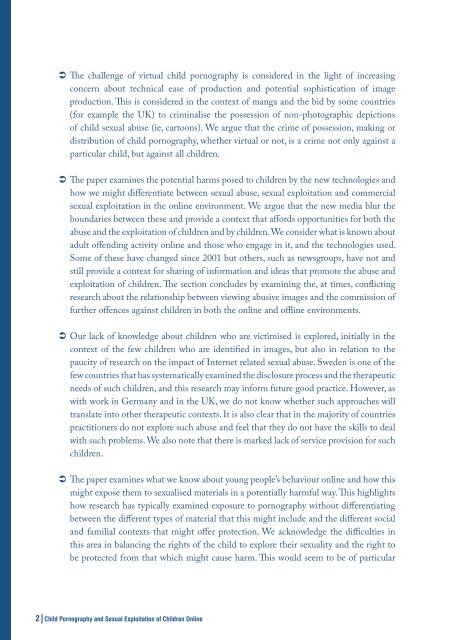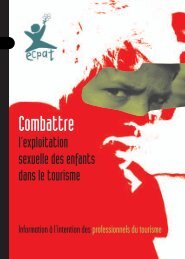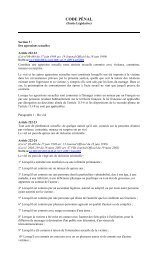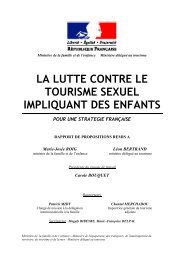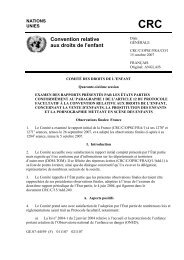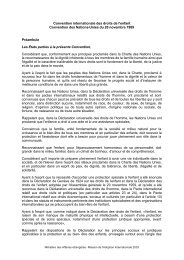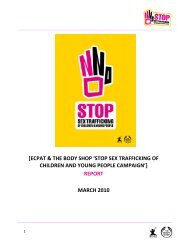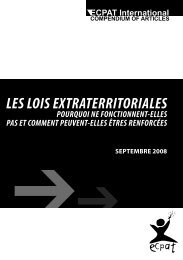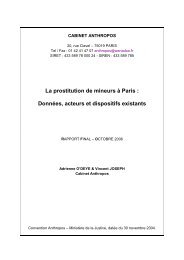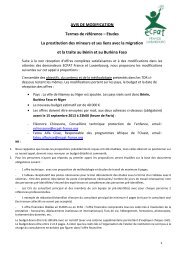child pornography and sexual exploitation of children online
child pornography and sexual exploitation of children online
child pornography and sexual exploitation of children online
You also want an ePaper? Increase the reach of your titles
YUMPU automatically turns print PDFs into web optimized ePapers that Google loves.
Ü The challenge <strong>of</strong> virtual <strong>child</strong> <strong>pornography</strong> is considered in the light <strong>of</strong> increasing<br />
concern about technical ease <strong>of</strong> production <strong>and</strong> potential sophistication <strong>of</strong> image<br />
production. This is considered in the context <strong>of</strong> manga <strong>and</strong> the bid by some countries<br />
(for example the UK) to criminalise the possession <strong>of</strong> non-photographic depictions<br />
<strong>of</strong> <strong>child</strong> <strong>sexual</strong> abuse (ie, cartoons). We argue that the crime <strong>of</strong> possession, making or<br />
distribution <strong>of</strong> <strong>child</strong> <strong>pornography</strong>, whether virtual or not, is a crime not only against a<br />
particular <strong>child</strong>, but against all <strong>child</strong>ren.<br />
Ü The paper examines the potential harms posed to <strong>child</strong>ren by the new technologies <strong>and</strong><br />
how we might differentiate between <strong>sexual</strong> abuse, <strong>sexual</strong> <strong>exploitation</strong> <strong>and</strong> commercial<br />
<strong>sexual</strong> <strong>exploitation</strong> in the <strong>online</strong> environment. We argue that the new media blur the<br />
boundaries between these <strong>and</strong> provide a context that affords opportunities for both the<br />
abuse <strong>and</strong> the <strong>exploitation</strong> <strong>of</strong> <strong>child</strong>ren <strong>and</strong> by <strong>child</strong>ren. We consider what is known about<br />
adult <strong>of</strong>fending activity <strong>online</strong> <strong>and</strong> those who engage in it, <strong>and</strong> the technologies used.<br />
Some <strong>of</strong> these have changed since 2001 but others, such as newsgroups, have not <strong>and</strong><br />
still provide a context for sharing <strong>of</strong> information <strong>and</strong> ideas that promote the abuse <strong>and</strong><br />
<strong>exploitation</strong> <strong>of</strong> <strong>child</strong>ren. The section concludes by examining the, at times, conflicting<br />
research about the relationship between viewing abusive images <strong>and</strong> the commission <strong>of</strong><br />
further <strong>of</strong>fences against <strong>child</strong>ren in both the <strong>online</strong> <strong>and</strong> <strong>of</strong>fline environments.<br />
Ü Our lack <strong>of</strong> knowledge about <strong>child</strong>ren who are victimised is explored, initially in the<br />
context <strong>of</strong> the few <strong>child</strong>ren who are identified in images, but also in relation to the<br />
paucity <strong>of</strong> research on the impact <strong>of</strong> Internet related <strong>sexual</strong> abuse. Sweden is one <strong>of</strong> the<br />
few countries that has systematically examined the disclosure process <strong>and</strong> the therapeutic<br />
needs <strong>of</strong> such <strong>child</strong>ren, <strong>and</strong> this research may inform future good practice. However, as<br />
with work in Germany <strong>and</strong> in the UK, we do not know whether such approaches will<br />
translate into other therapeutic contexts. It is also clear that in the majority <strong>of</strong> countries<br />
practitioners do not explore such abuse <strong>and</strong> feel that they do not have the skills to deal<br />
with such problems. We also note that there is marked lack <strong>of</strong> service provision for such<br />
<strong>child</strong>ren.<br />
Ü The paper examines what we know about young people’s behaviour <strong>online</strong> <strong>and</strong> how this<br />
might expose them to <strong>sexual</strong>ised materials in a potentially harmful way. This highlights<br />
how research has typically examined exposure to <strong>pornography</strong> without differentiating<br />
between the different types <strong>of</strong> material that this might include <strong>and</strong> the different social<br />
<strong>and</strong> familial contexts that might <strong>of</strong>fer protection. We acknowledge the difficulties in<br />
this area in balancing the rights <strong>of</strong> the <strong>child</strong> to explore their <strong>sexual</strong>ity <strong>and</strong> the right to<br />
be protected from that which might cause harm. This would seem to be <strong>of</strong> particular<br />
2|Child Pornography <strong>and</strong> Sexual Exploitation <strong>of</strong> Children Online


